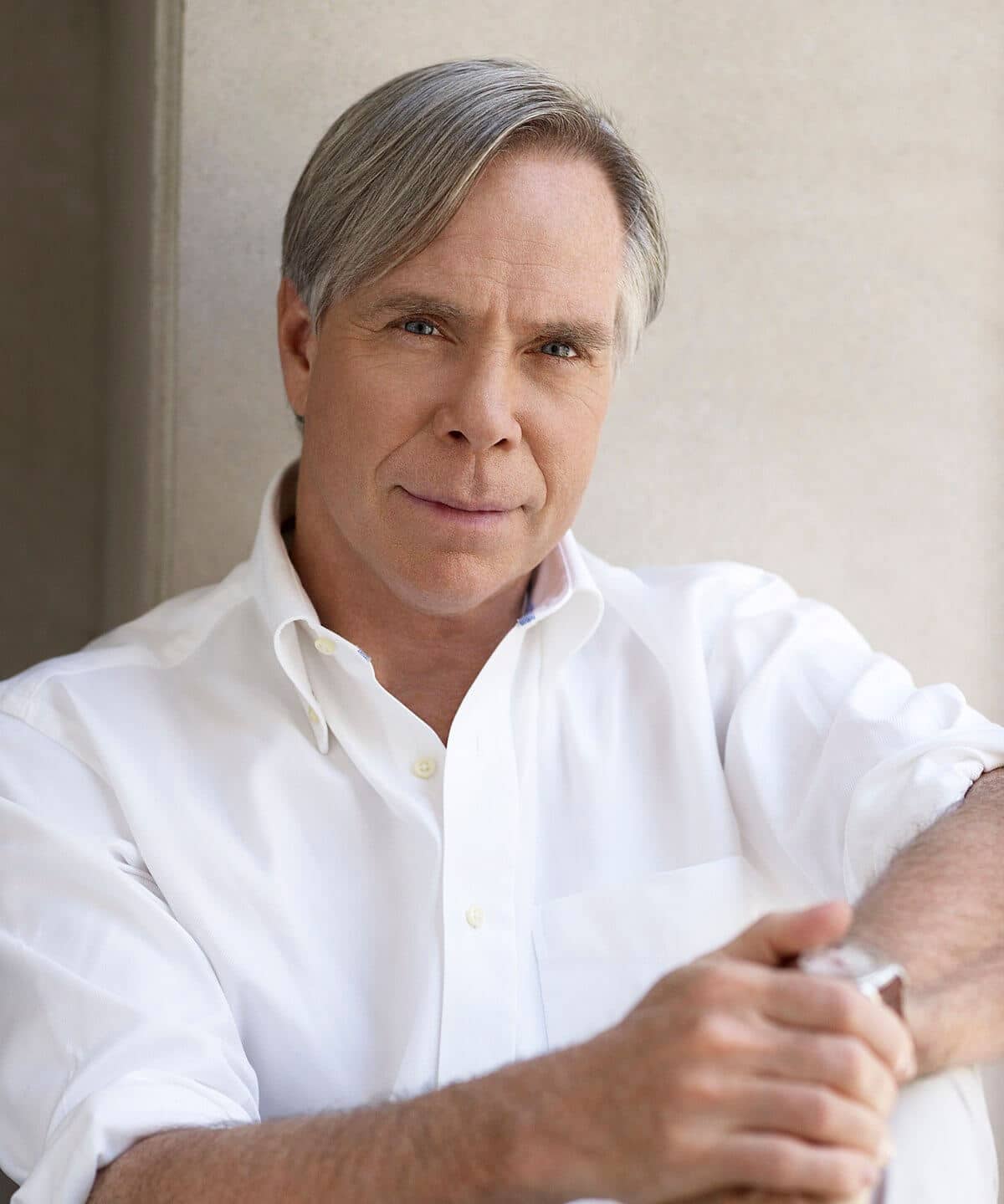Have you ever wondered about the financial standing of the people behind the most recognizable brands? It's a question many of us ask, particularly when a name becomes synonymous with a certain style. For someone like Tommy Hilfiger, whose name graces clothing racks around the world, the curiosity about his wealth is, you know, pretty natural. People often want to understand the scale of success, the kind of financial impact a fashion visionary can truly make.
It's interesting, really, to consider the journey from a small shop to a global powerhouse. When we ask "how much is Tommy Hilfiger worth," we're not just looking for a number. We're also trying to grasp the immense effort, the keen business sense, and the sheer persistence it takes to build something so enduring. It's about seeing the results of a creative vision meeting smart commercial decisions, and that, arguably, is quite inspiring.
This article aims to give you a clear picture of Tommy Hilfiger's financial journey. We'll explore his beginnings, the growth of his iconic brand, and what his personal wealth means in the grand scheme of the fashion world. So, in a way, we're going to pull back the curtain on a truly significant fortune.
Table of Contents
- Biography of Tommy Hilfiger: From Elmira to Global Fashion
- How Much Is Tommy Hilfiger Worth? The Numbers Behind the Name
- Building an Empire: The Journey to Much Wealth
- Tommy Hilfiger's Enduring Legacy
- Frequently Asked Questions
Biography of Tommy Hilfiger: From Elmira to Global Fashion
Thomas Jacob Hilfiger, a name that echoes in fashion halls, began his life in Elmira, New York. Born on March 24, 1951, he was one of nine children. His path into fashion wasn't through formal design school, which is that, kind of, a unique start. Instead, he started selling jeans from the trunk of his car, a rather humble beginning for someone who would later command a fortune.
His early experiences gave him a real feel for what people wanted to wear. He saw a gap in the market for stylish, well-fitting clothes that weren't overly expensive. This early understanding of consumer desire would, in fact, become a guiding principle for his future brand. It's a story of someone building something substantial from the ground up, more or less, with a lot of grit.
Personal Details & Bio Data
| Detail | Information |
|---|---|
| Full Name | Thomas Jacob Hilfiger |
| Date of Birth | March 24, 1951 |
| Place of Birth | Elmira, New York, USA |
| Nationality | American |
| Occupation | Fashion Designer, Entrepreneur |
| Spouse(s) | Susie Hilfiger (m. 1976; div. 2000), Dee Ocleppo (m. 2008) |
| Children | 5 |
How Much Is Tommy Hilfiger Worth? The Numbers Behind the Name
When people ask "how much is Tommy Hilfiger worth," they are often looking for a specific figure, a concrete amount. As of recent reports, Tommy Hilfiger's personal net worth is estimated to be in the range of several hundred million dollars, often cited as over $450 million. This kind of wealth, you know, represents a truly great quantity of financial success.
The meaning of "much" here is "great in quantity, amount, extent, or degree," which certainly applies to a fortune of this size. It's a large amount, to a very large degree, showing a substantial extent of financial achievement. This figure isn't just from his salary, of course. It comes from decades of brand building, smart business deals, and the eventual sale of his company, which we will discuss. It’s a reflection of a career that saw him create something from almost nothing, and that, pretty much, is remarkable.
It's important to remember that net worth estimations can change, depending on market conditions and investments. However, the consistent reporting of his wealth at this level shows the deep impact and lasting value of his contributions to fashion. So, really, it's a testament to his long-term vision and business acumen.
Building an Empire: The Journey to Much Wealth
The path to accumulating such a significant fortune for Tommy Hilfiger was a long one, marked by innovation and strategic decisions. It wasn't an overnight success, but rather a gradual build-up of influence and market share. This journey, you know, offers some interesting insights into the fashion business.
Early Days and First Steps
Tommy Hilfiger's initial foray into retail began in 1969 with a small chain of stores called People's Place in upstate New York. He would buy jeans in New York City, customize them, and sell them back home. This was his first taste of the fashion business, and it gave him a practical education in what customers wanted and how to run a shop. He learned a lot about how to use "much" effort in those early days, as he really put in a large amount of work.
Despite some early successes, People's Place eventually faced financial challenges and closed in 1977. This period, while tough, provided invaluable lessons. It taught him about the ups and downs of business, and the need for a truly solid foundation. It was, arguably, a crucial learning curve that prepared him for bigger things.
The Launch of an Iconic Brand
After moving to New York City, Hilfiger worked for various companies before launching the Tommy Hilfiger Corporation in 1985. His debut collection featured updated versions of classic American styles, like button-down shirts, chinos, and polo shirts. The look was preppy with an edge, and it quickly resonated with a youthful audience. This was, in a way, a turning point.
The brand's initial marketing was bold and attention-grabbing. Advertisements famously put Hilfiger in the same league as established American designers, which was, you know, a very confident move for a newcomer. This strategy helped create a lot of buzz and quickly positioned the brand as a significant player in the fashion scene. It helped him gain a far larger amount of recognition than many might expect so early on.
Global Expansion and Strategic Moves
Throughout the late 1980s and 1990s, the Tommy Hilfiger brand experienced rapid growth. The company went public in 1992, which brought in substantial capital for further expansion. They expanded into women's wear, fragrances, and various accessories, building a lifestyle brand rather than just a clothing line. This expansion was, basically, a huge part of accumulating his wealth.
The brand became particularly popular within the hip-hop community, which gave it a cool, street-smart appeal that broadened its market considerably. This organic adoption by influential figures helped propel sales and cemented its place in popular culture. It showed, quite clearly, how much influence a brand could gather through cultural relevance.
The Sale of the Company and Continued Influence
In 2006, Tommy Hilfiger sold his company to Apax Partners, a private equity firm, for approximately $1.6 billion. He remained the company's principal designer and creative director. This sale significantly boosted his personal wealth, marking a major financial milestone. Then, in 2010, Apax Partners sold the company to Phillips-Van Heusen (PVH Corp.), which also owns Calvin Klein, for about $3 billion. This further solidified the brand's standing and Hilfiger's legacy.
Even after these sales, Tommy Hilfiger has remained actively involved with the brand, guiding its creative direction and maintaining its core identity. His continued presence helps ensure the brand stays true to its roots while adapting to new trends. He still has a very, very significant say in things, which is quite something.
Tommy Hilfiger's Enduring Legacy
Tommy Hilfiger's net worth is a clear indicator of his remarkable success as a fashion entrepreneur. His ability to create a brand that resonates across generations and cultures is a testament to his vision. He didn't just sell clothes; he sold a lifestyle, an idea of classic American cool with a modern twist. This approach, you know, has had a very lasting impact.
His story serves as an example of how much dedication and creative drive can lead to immense financial reward. It shows that with a clear vision and smart business decisions, one can build a global empire from relatively modest beginnings. His legacy is not just in the clothes, but also in the business model he perfected, which is, actually, quite inspiring for many.
To learn more about fashion industry leaders on our site, and for deeper insights into the business of iconic brands, you can explore our other articles. The journey of Tommy Hilfiger is a powerful reminder that with enough passion and strategic thinking, a person can achieve a truly substantial amount of success, as seen in his impressive net worth, which is, in fact, great in quantity.
Frequently Asked Questions
How did Tommy Hilfiger build his fashion empire?
Tommy Hilfiger built his fashion empire by starting with a small chain of stores, learning the retail business, and then launching his own brand in 1985 focusing on updated American classics. He used bold marketing, expanded into various product lines, and successfully appealed to a wide demographic, including the hip-hop community, which helped propel his brand's popularity and financial success. It was, you know, a very strategic build.
Is Tommy Hilfiger still involved with his company?
Yes, Tommy Hilfiger remains actively involved with the brand that bears his name. Even after the company was sold to Apax Partners in 2006 and later to PVH Corp. in 2010, he has continued to serve as the principal designer and creative director. His ongoing presence helps shape the brand's direction and maintain its core identity, which is, basically, quite important for the brand.
What is the value of the Tommy Hilfiger brand today?
The Tommy Hilfiger brand itself is a highly valuable asset within the portfolio of PVH Corp. While specific current market valuations for the brand alone can vary, PVH Corp. acquired the brand for approximately $3 billion in 2010. Its continued global presence, strong sales, and consistent market relevance show it retains a very, very significant value in the fashion industry. It's, truly, a major player.



Detail Author:
- Name : May Dicki
- Username : clinton20
- Email : lemke.juvenal@hotmail.com
- Birthdate : 1971-10-21
- Address : 37201 Liliane Shores Lake Sydneechester, GA 12218
- Phone : 1-380-575-5010
- Company : Runte-Dibbert
- Job : Benefits Specialist
- Bio : Enim labore vel laudantium fugit debitis esse mollitia. Maiores qui doloribus est. Dolorem repellendus iusto eveniet qui quia. Doloribus necessitatibus iusto id quibusdam expedita officia.
Socials
twitter:
- url : https://twitter.com/denesikl
- username : denesikl
- bio : Optio adipisci est totam provident. Qui est error tenetur dolorem sed tempore. Deleniti consequatur aperiam rem.
- followers : 1386
- following : 44
instagram:
- url : https://instagram.com/laynedenesik
- username : laynedenesik
- bio : Qui quo impedit ut tempora ipsum. Soluta ipsam doloribus omnis sit at.
- followers : 5766
- following : 2099
tiktok:
- url : https://tiktok.com/@ldenesik
- username : ldenesik
- bio : Voluptatum nulla ab quia eaque dolores sit nam.
- followers : 6887
- following : 1052
facebook:
- url : https://facebook.com/ldenesik
- username : ldenesik
- bio : Magni est quisquam distinctio. Sequi delectus et molestiae eligendi.
- followers : 3494
- following : 1388
linkedin:
- url : https://linkedin.com/in/layne_denesik
- username : layne_denesik
- bio : Nulla ad corrupti ex omnis sequi hic.
- followers : 342
- following : 1471